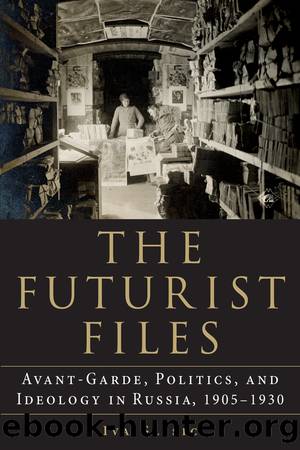The Futurist Files by Glisic Iva;

Author:Glisic, Iva; [Glisic, Iva]
Language: eng
Format: epub
Publisher: Cornell University Press
Trotsky, however, famously noted that these clubs, though they did indeed represent an ideal foundry for the new proletarian consciousness, would first require people to visit them for that concept to work—a problem also lamented within LEF.100 Workers’ clubs were envisaged as crucibles of proletarian culture, a place where community could be formed and a platform for education and relaxation, but the reality (noted by the LEF collective) was almost the complete opposite. Existing clubs were generally tiny rooms in which workers attended tiresome meetings after already having completed a full day of work. They were either bad hybrids of taverns and theaters or, alternatively, monasteries where tirades were directed against the consumption of alcohol and the decadent life. Instead of showers, massage rooms, well-equipped reading rooms, a radio room, a photo laboratory, and crèche, these places at best housed cheap cinemas and dancing halls. Although the clubs were envisaged as centers where current issues could be absorbed and discussed, the reality was a source of significant irritation to the Futurists—and adding to the frustration, the budget allocated to these clubs was usually spent on useless decoration. The dedication of club budgets to the procurement of portraits of leaders, the creation of slogans, and a tree for the celebration of the New Year was evidence of an inability to sever ties with the mentality of a defunct era. LEF’s notion of having a maximum program but working within the realms of the possible and implementing a minimum program was the mentality missing within the cultural administration. The example of workers’ clubs is again evocative of Punin’s early articles in Iskusstvo kommuny where he warned that the new reality could not be mounted with the kak podoidet (whatever fits) mentality.101
Futurists campaigned strongly for Soviet officialdom to adopt a different strategy for these clubs, offering a solution in LEF. Enticing workers into these clubs could not be seen as a concept of peripheral importance, and officials needed to embrace the workers’ club as a vital tool for facilitating the birth of the new lifestyle. If workers were in any way averse to entering the clubs, then the entire concept needed to be reconsidered. Clubs must be brought to the people, to the places of their spontaneous gathering, be it a buffet, or a corridor, or a place where people would simply gather to converse. Any space where people naturally came together could potentially be turned into a space capable of instilling a new mind-set—to the foyer of a cinema, for example, might be added a bookshop, a reading room, a telephone, resources with which better use could be made of the time that would otherwise be simply spent waiting. LEF hailed the Mostorg store as an inspiration as this was a space where one could not only buy things but also make a telephone call, have breakfast, read the newspaper, write a letter, simply do everyday things and feel comfortable without any desire to leave. The fact that citizens were able to
Download
This site does not store any files on its server. We only index and link to content provided by other sites. Please contact the content providers to delete copyright contents if any and email us, we'll remove relevant links or contents immediately.
The Secret History by Donna Tartt(18157)
Red Sparrow by Jason Matthews(5195)
Harry Potter 02 & The Chamber Of Secrets (Illustrated) by J.K. Rowling(3555)
In a Sunburned Country by Bill Bryson(3364)
Drawing Cutting Edge Anatomy by Christopher Hart(3290)
Figure Drawing for Artists by Steve Huston(3267)
Harry Potter and the Prisoner of Azkaban (Book 3) by J. K. Rowling(3108)
The Daily Stoic by Holiday Ryan & Hanselman Stephen(3107)
Japanese Design by Patricia J. Graham(2997)
The Roots of Romanticism (Second Edition) by Berlin Isaiah Hardy Henry Gray John(2819)
Make Comics Like the Pros by Greg Pak(2757)
Stacked Decks by The Rotenberg Collection(2685)
Harry Potter and the Deathly Hallows (7) by J.K. Rowling(2549)
Draw-A-Saurus by James Silvani(2501)
Tattoo Art by Doralba Picerno(2484)
On Photography by Susan Sontag(2481)
Foreign Devils on the Silk Road: The Search for the Lost Treasures of Central Asia by Peter Hopkirk(2385)
Churchill by Paul Johnson(2360)
The Daily Stoic by Ryan Holiday & Stephen Hanselman(2341)
